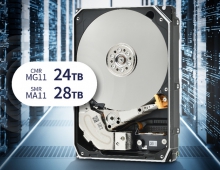
Toshiba Sees High Demand For Energy Efficient Enterprise HDDs
The growth of digital data is driving big changes in the type of IT infrastructure and storage devices required to meet today's challenges. Toshiba anticipates an increasing demand for 3.5-inch, capacity-optimized, enterprise-class hard disk drives.
There are many reports regarding the massive amounts of digital data being created, as well as predictions of exponential growth in stored data, altogether accelerated by feature rich mobile devices. Compounded by the development of emerging markets joining the networked world, the capacity and scalability required to manage all this data is driving demand for new initiatives and designs in cloud computing and cloud infrastructure services. It's all about reducing costs and providing more efficient ways to store data.
Facebook, for example, already hosts more than 240 billion user photos with an additional 350 million photos uploaded every day. It doesn't take long before these photos become old and outdated by new photos and the recurrence of access to such content shifts from frequently to rarely. Inherently, a growing percentage of all this digital data is actually considered secondary data, aka cold data -- data that must be retained, is rarely accessed, but stored with an important metric in mind: total cost of storage. There are many other examples of secondary data out there too; video files, emails, audit and security logs, web logs, and compliance data are created every day within business and governments all over the world.
Just dealing with all this data being uploaded daily is causing data center designers, IT managers, and compliance officers to reconsider their existing enterprise infrastructure and cost management.
Toshiba says that cold storage is a natural evolution for secondary data. The type of server systems being designed for cold storage data centers will have as much as eight times the capacity of traditional large scale, high-IOPS storage systems supporting mission critical databases. In addition, the cold storage systems will be as much as five times more energy efficient while costing as much as one third less than traditional server systems.
Now, in the disk drive manufacturers' world, all this growth of digital content and cold data archiving will push the traditional enterprise market to demand higher capacity storage products that continue to deliver enterprise-class features and reliability, while being more cost effective and energy efficient.
Toshiba anticipates an increasing demand for 3.5-inch, capacity-optimized, enterprise-class hard disk drives. Focusing on energy efficiency, these drives will need to meet key requirements of cold storage systems: cost per capacity, power consumption, and robust data integrity. Massive 4TB business-critical and nearline-class drives are available today with even higher capacity points in the works. Such growth in drive capacity will help keep pace with data growth. To help reduce costs, anticipate disk drive manufacturers to lower a drive's power consumption even further by reducing drive spin speed from 7,200 to 5,x00 RPM, thereby saving an estimated 3 ~ 5W of operating power per drive. The new cold storage data center designs will have up to tens and even hundreds of thousands of such drives, so small improvements at the device level will add up to significant power savings.
Facebook, for example, already hosts more than 240 billion user photos with an additional 350 million photos uploaded every day. It doesn't take long before these photos become old and outdated by new photos and the recurrence of access to such content shifts from frequently to rarely. Inherently, a growing percentage of all this digital data is actually considered secondary data, aka cold data -- data that must be retained, is rarely accessed, but stored with an important metric in mind: total cost of storage. There are many other examples of secondary data out there too; video files, emails, audit and security logs, web logs, and compliance data are created every day within business and governments all over the world.
Just dealing with all this data being uploaded daily is causing data center designers, IT managers, and compliance officers to reconsider their existing enterprise infrastructure and cost management.
Toshiba says that cold storage is a natural evolution for secondary data. The type of server systems being designed for cold storage data centers will have as much as eight times the capacity of traditional large scale, high-IOPS storage systems supporting mission critical databases. In addition, the cold storage systems will be as much as five times more energy efficient while costing as much as one third less than traditional server systems.
Now, in the disk drive manufacturers' world, all this growth of digital content and cold data archiving will push the traditional enterprise market to demand higher capacity storage products that continue to deliver enterprise-class features and reliability, while being more cost effective and energy efficient.
Toshiba anticipates an increasing demand for 3.5-inch, capacity-optimized, enterprise-class hard disk drives. Focusing on energy efficiency, these drives will need to meet key requirements of cold storage systems: cost per capacity, power consumption, and robust data integrity. Massive 4TB business-critical and nearline-class drives are available today with even higher capacity points in the works. Such growth in drive capacity will help keep pace with data growth. To help reduce costs, anticipate disk drive manufacturers to lower a drive's power consumption even further by reducing drive spin speed from 7,200 to 5,x00 RPM, thereby saving an estimated 3 ~ 5W of operating power per drive. The new cold storage data center designs will have up to tens and even hundreds of thousands of such drives, so small improvements at the device level will add up to significant power savings.





















